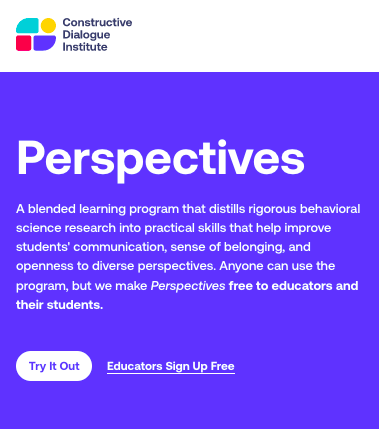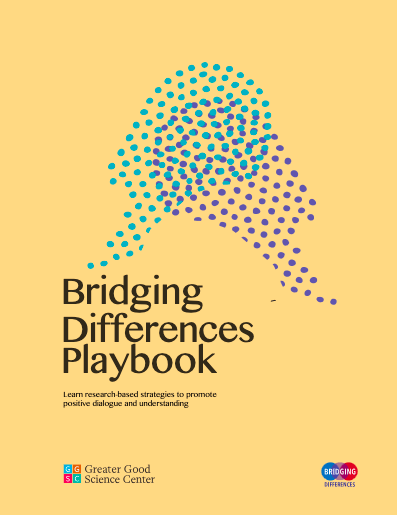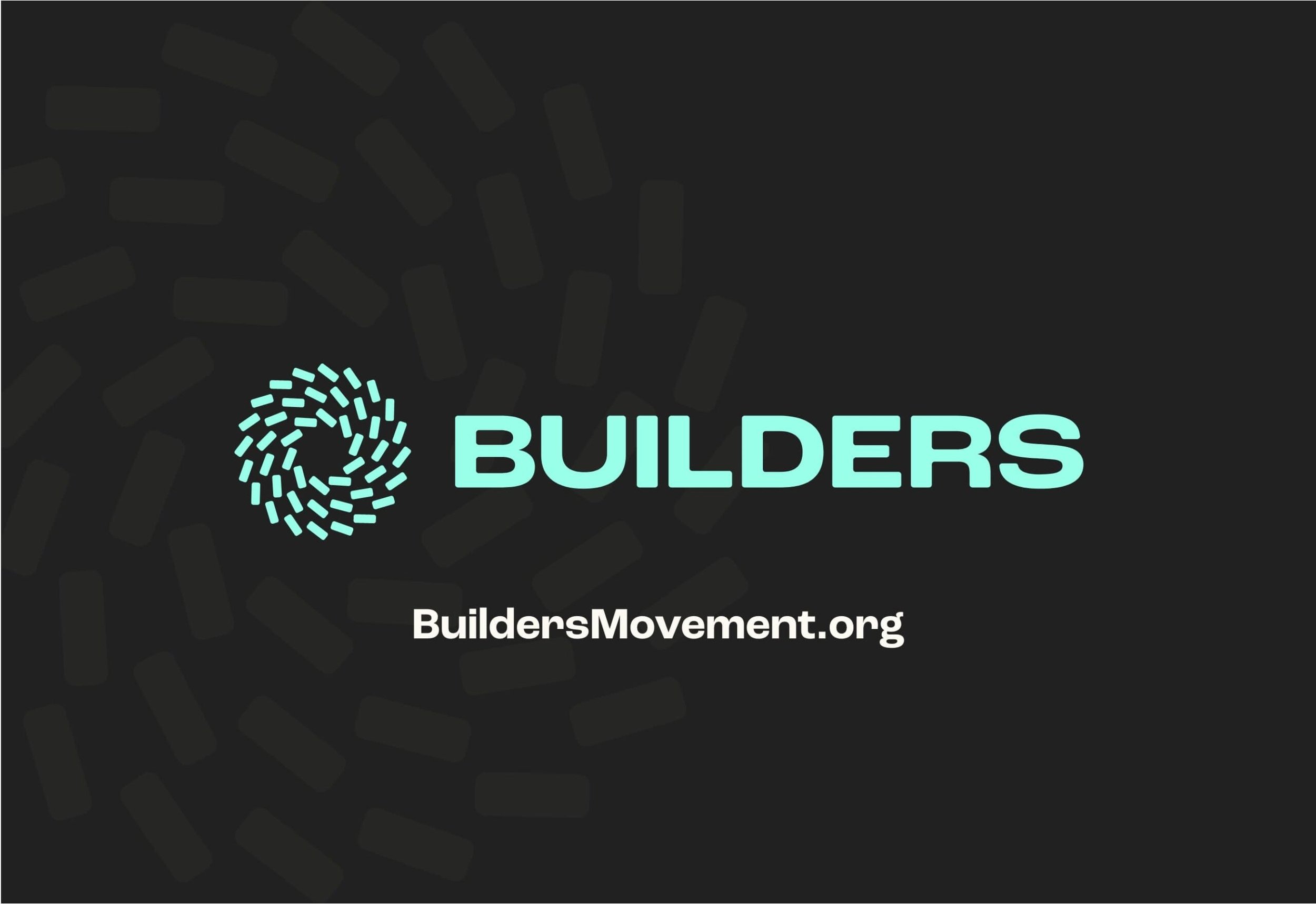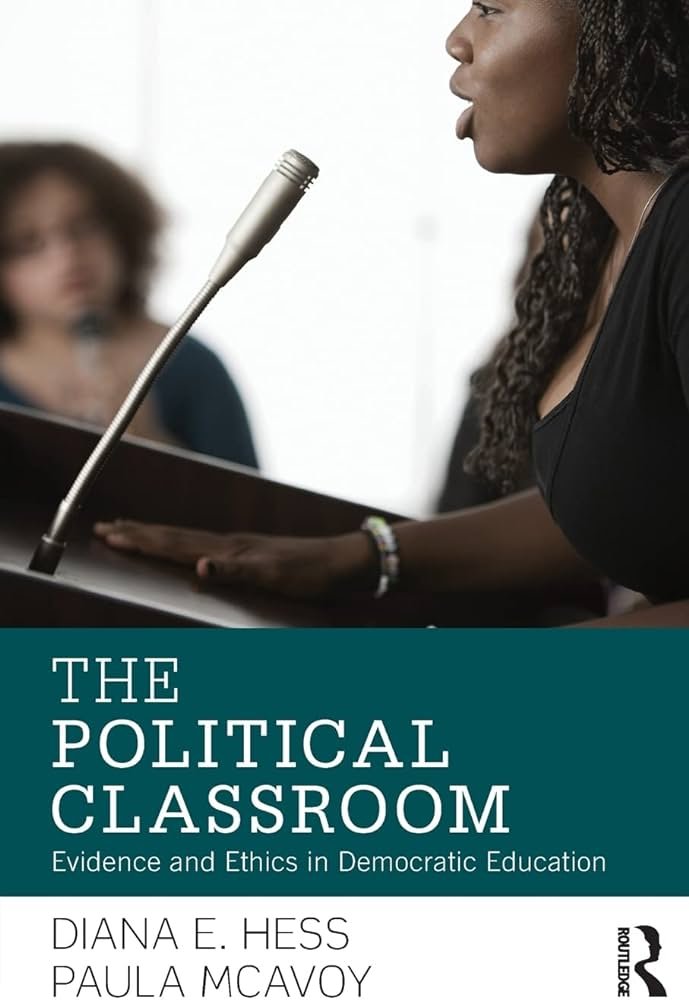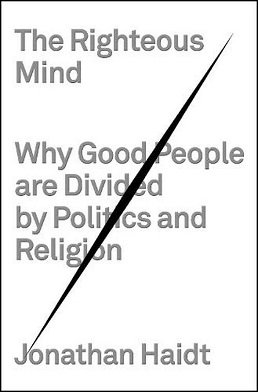
Resources
This resource from the Better Arguments Project uses an exploration of current events to reinforce listening skills.
Oh look! Another one from the Greater Good Science Center! A simple list of sentence stems to grease the wheels of productive dialogue.
Classroom Lesson Ideas
Lesson plan for building collaborative class norms from the Greater Good Science Center.
This also comes from the Greater Good Science Center. Each of these lessons, along with 13 others, are part of the more comprehensive set of “15 Practices,” linked in the section below.
The Canadian Friends Service Committee has packaged a full years-worth of weekly tips for navigating difficult discussions. I could imagine featuring one per week in a class— or just using a handful throughout the year.
LARA method for tense talks (Listen, Affirm, Respond, Ask Questions) from Stanford
Sort of like a four-corners exercise— this lesson from Facing History eases students into taking a position and listening to the positions of their peers.
Six-session curriculum for middle- and upper-school students from the Better Arguments Project (provide your contact info to complete the download process). Facilitate productive conversations across lines of difference.
Comprehensive Curricular Materials
Eight-session curriculum from the Constructive Dialogue Institute explores the science that explains our divisions and provides suggestions to reach across lines of divide.
Nine-lesson framework from the Builders Movement, with lessons divided into three sections: curiosity, compassion, and courage.
“Let’s Talk” from Learning for Justice. A lengthy, detailed guide, full of practical, concrete suggestions to lead critical conversations across all grade ranges.
Bridging Differences Playbook from the Greater Good Science Center. Dozens of lessons to help students reach across ideological divides. Try pages 44-50: “Listen with Compassion” and “Put People Before Politics.”
15 Practices to Help Kids Bridge Differences, from the Greater Good Science Center, is organized into 15 different lesson plans.
The product of Harvard’s Making Caring Common, Rural Assembly, and Generation Citizen. Includes a wealth of resources to lead students through dialogue across difference.
Brief Videos for Classroom Use
Three-minute news piece from CBS reunites political opposites who met on a rafting trip for a discussion now that Trump is back in office.
This engaging four-minute video from Beyond Conflict demonstrates that Americans are not nearly as divided as we think we are.
Five-minute video from the Greater Good Science Center in which political opposites discover a shared sense of humanity. Great inspiration for kids and adults alike!
This inspiring message from Utah’s gubernatorial candidates is only a minute long!
This is different. It’s a five-minute clip of a panel of conservatives talking in 2025 about Trump’s first months in office. Half support him, half do not. In some ways, this is the most powerful and important video of the bunch. See the full, two-hour conversation here. Kudos to Braver Angels for providing this sort of programming.
Six-minute summary of the “America in One Room” project, in which a politically diverse group of hundreds of Americans from across the country convened for a weekend of cross-partisan conversation.
Seven-minute introduction to the power of storytelling to engender empathy, as implemented by Narrative Four.
At eight minutes, a longer news piece, also covering the R.A.F.T. program that puts political opposites in the same boat— literally. Includes good references to research on polarization.
Watch the first 3:40 of this brief video from the Constructive Dialogue Institute to consider how upbringing affects one’s lasting worldview.
Brief, uplifting message of unity found on the homepage of conversation.us.
The First Step follows Van Jones as he tries to push for criminal justice reform in an era of political polarization. This is a powerful film. Spicy language for several minutes starting midway through— otherwise fit for all audiences.
This Land was shot on election day, 2020, by filmmakers across the country. It sounds great; haven’t seen it.
Documentaries
Purple, a 21-minute documentary from Resetting the Table, presents Americans with opposing viewpoints in civil conversation about what divides them.
University of Virginia students produced a good documentary about conversation— and cooperation— among UVA students across the political spectrum. Called Common Grounds?, it’s about 25 minutes long.
A Road Trip Across a Divided America is among the six films featured in the 2025 Better Together Film Festival. Looks good, and the jury that selected it says it’s a good candidate for a youth audience.
Divided We Fall: Unity Without Tragedy is another in this bumper crop of documentaries that show Americans across the political divide discussing (with civility) divisive issues; would be better for high-schoolers than middle-schoolers.
Dialogue Lab: America documents a gathering of politically heterogeneous adults and their structured discussions. A handful of exchanges are quite powerful, and those could be shown to teachers or older students as inspiration for those looking to reach across lines of disagreement.
Undivide Us is really good. Like several other documentaries, it gathers together people from across the divide for challenging conversation; it does this especially well.
The Tennessee 11: also one of the 2025 Better Together films, and also judged by the jurors to be a good fit for a youth audience. This one is about seeking solutions to gun violence.
Conversation.us serves as the landing page for the Listen First Coalition, comprised of hundreds of organization working to depolarize the country. Clean website provides lots of resources and next steps.
AllSides for Schools is a division of AllSides, an organization that provides “balanced news and civil discourse.” This is a good site to visit when looking for a range of news from left, right, and center.
Organizations
The Builders Movement aims to “equip citizens to overcome toxic polarization and solve our greatest problems together.” Lively website, not focused specifically on education, but lots of inspiration and resources.
Braver Angels is a major force in the world of bridging. Lots of podcasts, webinars, debates, etc. intended to depolarize America. They seem to be the organization that is most genuinely grounded in participation among conservatives and liberals.
The Constructive Dialogue Institute has a deep bench of thinkers generating a thoughtful vision for civil discourse, mainly in the university setting, but also high schools. They offer insightful webinars, too.
Bridging Differences, an initiative of the Greater Good Science Center, is essentially a one-stop shopping center of research and insight into reaching across lines of difference; it’s an excellent resource.
Strangers in their Own Land, by Arlie Russell Hochschild, is unparralled. For a master class in empathy, delivered by a self-professed liberal sociology professor who embeds herself in the lives of disillusioned Tea Party members in Louisiana, read this book.
The Political Classroom, by Paula McAvoy and Diana Hess, contends that classrooms should include dialogue about controversial topics; the book offers advice about how to make that happen.
Books
Wow. The Chaos Machine, by Max Fisher, is required reading for those who want to know how social media has so quickly and so drastically fomented extremism and supercharged polarization.
Jonathan Haidt is a towering figure in moral psychology, and his work has paved the way to better understand the psychological roots of our national divisions. The Righteous Mind explains all.
Uncivil Agreement, by Liliana Mason, helps the reader understand that the intensity of our national, political divide can be explained by the advent of what she calls “mega-identities.” Increasingly, the various aspects of our identity—including political allegiance— are layering on top of each other, reinforcing and amplifying each other, so that political threats cut to the core of our identities; the stakes are raised.
Why We’re Polarized, by Ezra Klein, provides one-stop shopping for those looking for the full story as to why our society is in this predicament.
Although Bill Bishop’s The Big Sort has now been in print for over a dozen years, it remains an authoritative source of information on how we Americans— to our detriment— have increasingly divided and segmented ourselves into like-minded communities.









